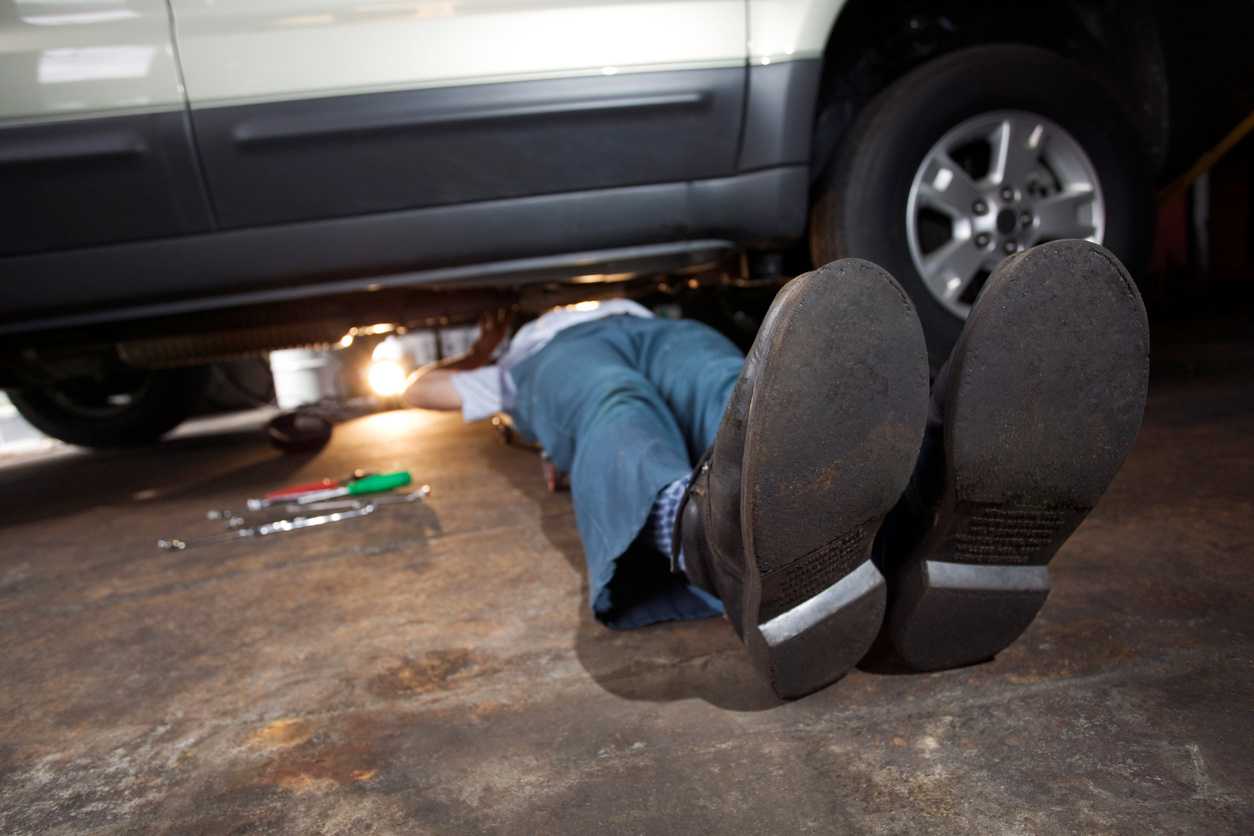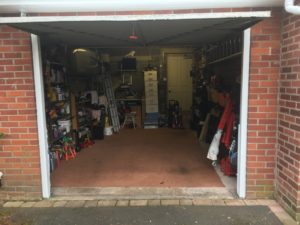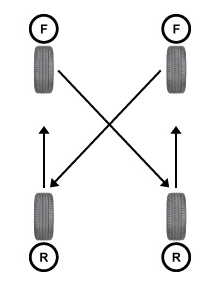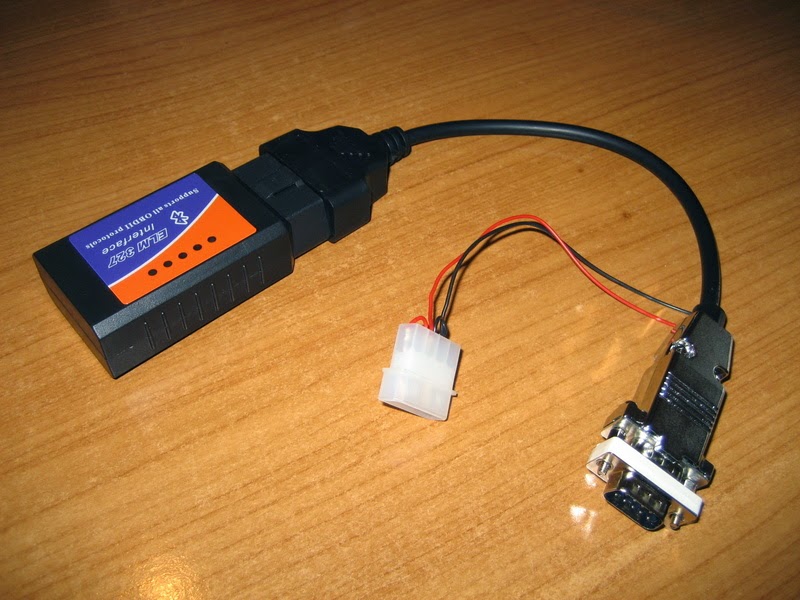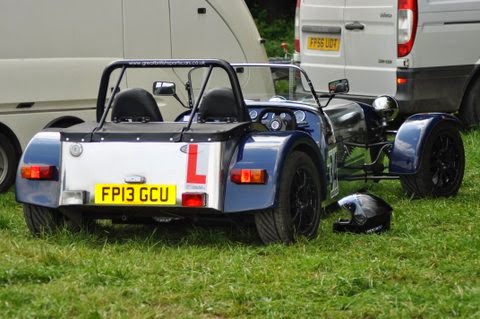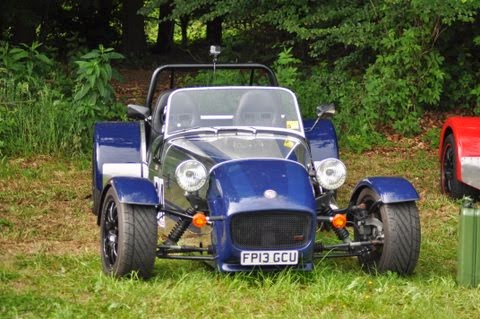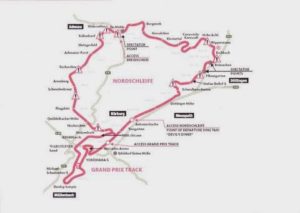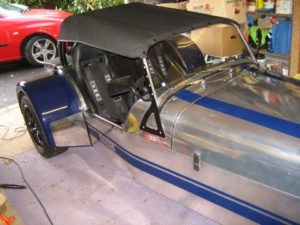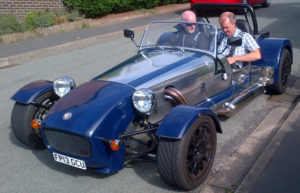Here is a step-by-step history of my build. Hoe I approached it. The problems I encountered and how I resolved them. I hope that you find it interesting and helpful, especially if you are also a Zero builder.
The Final Chapter
The Final Chapter
Recently I’ve been thinking about a new project.It’s been over three years now since the Zero was finished, and whilst I have had so much fun diving her, it is time for something new.
I advertised in Autotrader 1 week ago – over 1000 views and numerous buyers. The luck chap was Peter from Norfolk who drove up with the cash on Sunday and drove back with by Zero.
So sad to see her go 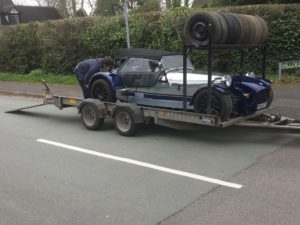
Now what’s next…….
Winter Maintenance
 Quite straight forward job (even with a garage temperature of 3 degrees). The old pads and the discs themselves were hardly touched after 7000 miles – can’t be driving hard enough. The pistons needed a little bit of cleaning before greasing up and re-assembling. Job done and much improved.
Quite straight forward job (even with a garage temperature of 3 degrees). The old pads and the discs themselves were hardly touched after 7000 miles – can’t be driving hard enough. The pistons needed a little bit of cleaning before greasing up and re-assembling. Job done and much improved.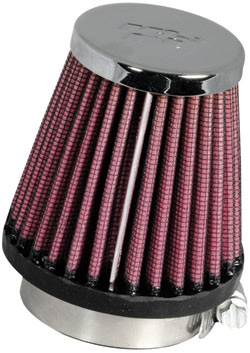 Two turns clockwise on the idle stop screw – done. Far too much – warm idle now 2000rpm. Wound it back to initial position and added a very slight adjustment for warm idle at c1000rpm.
Two turns clockwise on the idle stop screw – done. Far too much – warm idle now 2000rpm. Wound it back to initial position and added a very slight adjustment for warm idle at c1000rpm.RhoCar Scotland 2015
Finally got around to finishing the video footage from the trip
Day One
Day Two
Day Three
Day Four
Torque App interface to Emerald – Part 2
Finally got around to finishing off this project after the ECU firmware upgrade when I visited Emerald a while ago.
I have hidden the small loom and bluetooth ODBII interface under the dash and simply mounted the Kindle on the dash with a couple of small peices of velco so it can be easily removed and replaced.
I now have an in-car entertainment system, navigation and engine management system on the dash.
New Emerald ECU mapping
In my previous post I wrote about my recent project to build a bluetooth interface between the Torque app and the Emerald ECU. I almost succeeded but needed the firmware on the Emerald ECU upgrading. This requires the ECU to be physically at the Emerald premises in Watton just outside Norwich. As I didn’t want to trust my ECU to the postman I decided to drive across and whilst there to utilise their rolling road service to properly may the engine.
Here’s a short clip of the process:
Each load cell on the map is visited and the optimum parameters are selected depending on the map you want. With a catalyst and a plenum fitted I didn’t have as many options as a non catalyst engine with throttle bodies, but I decided on:
- Map 1 – Road and track
- Map 2 – MOT – low emissions (not for driving on)
- Map 3 – Immobiliser
Fairly self explanatory apart from Map 3. When set to Map 3 the car will just about start but will stall the moment you touch the pedal. A simple but effective way of immobilising the car in addition to the standard Ford key. There were other appealing/novelty options like “pop & bang” but this was my selection.
The trip was c165 miles each way so I had chance to test the car on the way home – what a difference!! Far more responsive. Much much smoother to drive. Motorway cruising at anywhere between 45 and 85 can now be done in 5th. It drinks much less fuel by at least 20%.
By the way the power run gave a reading of exactly 160 BHP at the flywheel. Not bad for a standard Ford engine with a simple plenum.
I must admit to having my fingers firmly crossed during the session. The car gets quite a hammering especially at high revs under full load. Cooling system and oil pressure both fine afterwards, but there was a trace of a slightly slippy clutch when everything got really hot. Nothing noticed on the way home though.
Torque App Interface to Emerald ECU
The idea here is to use a Kindle Fire HDX as a central hub for car information and mount it on the dashboard. Google maps for sat-nav, music via headphones, GoPro app for the camera and engine/vehicle information via the Torque Pro app. All of these apps are available now on the Kindle Fire, loaded and ready to go. Only the real-time engine data required for the Torque Pro app is missing.
According to the information on the Emerald web site the K6 ECU uses the following version of the CAN bus protocol: CAN v2.0b – 29-bit ID , Extended frame, 20Hz (up to 1 Mbit/sec). 21 elements of vehicle data are broadcast each second in the format defined by this protocol via the serial comms port on the K6. For the avoidance of doubt this is the same comms port that is normally used to upload the vehicle maps.
According to the various web sites for ELM 327 (and its clones) this ODB II interface should
also supports this protocol, and should interface with the Torque Pro app via Bluetooth, on my phone and android tablet. Sounds simple and also inexpensive as none of the elements required are more than a tenner.
Firstly the ELM 327 – Bluetooth version off E-bay for £5. Plugged it into my Audi and it connected straight away and pumped out vehicle data in the Torque Pro app for display. Simple 10 minute job. The Torque Pro Apps automatically tries all of the protocols it understands one after another until it gets a sensible response. It didn’t take more than a few seconds to latch on the one Audi is using.
So how to get the data from the K6 into the Torque Pro App? RS232 would have been my first choice but Emeralds comms port is not a standard RS232 implementation so there no easy solution there that doesn’t involve wires and a soldering iron. As I now know the ELK 327 works from my Audi test my idea is to build a bespoke cable that plugs into the 9 pin Dsub of the K6 ECU comms port and the other end allows the ELM 327 to be plugged in.
I came up with the following:
|
ECU Dsub 9 pin number
|
ECU Desc
|
Wire Colour
|
ODB Desc
|
ODB II 16 pin number
|
|
|
1
|
CAN_H **
|
CAN bus interface1
|
Purple
|
CAN H
|
6
|
|
2
|
CAN_L **
|
CAN bus interface1
|
White
|
CAN L
|
14
|
|
3
|
–
|
Not used
|
|||
|
4
|
–
|
Not used
|
|||
|
5
|
earth
|
Signal earth
|
Light blue & yellow
|
Ground
|
4 & 5
|
|
6
|
–
|
Not used
|
|||
|
7
|
Rx
|
RS232 serial interface, data receive
|
Black white
|
TxRx
|
7
|
|
8
|
Tx
|
RS232 serial interface, data transmit
|
Black
|
TxRx
|
15
|
|
9
|
CTS
|
RS232 serial interface, clear to send
|
Red white
|
8
|
21st Feb Update
Spoke to Emerald – the firmware in my ECU needs updating in order to start seeing CAN bus messages. It’s a free upgrade but at the factory. Will try to find a suitable day to go across to Norwich for the upgrade and a rolling road session.
Winter Maintenance
Job 1: Exhaust
 As you will have seen in previous posts, (and heard if you were on the GBS Run-Out) my exhaust was rattling again – badly. I had already attempted a fix according to instructions from Richard@GBS which had temporarily quietened it, but it had returned.
As you will have seen in previous posts, (and heard if you were on the GBS Run-Out) my exhaust was rattling again – badly. I had already attempted a fix according to instructions from Richard@GBS which had temporarily quietened it, but it had returned.
Richard@GBS agreed to take the unit apart and fix it properly in the factory. All I needed to do was get it to him. What could be simpler? Unbolt the silencer box and take it to the factory.
TIP FOR NEW BUILDERS: Cut the manifold pipe such that the silencer box can be slipped on and off without having to remove the exhaust bracket at the back or the manifold itself at the front.
Of course, I didn’t think of this at the time, so the manifold had to come off in order to remove the silencer box. See picture above – a little soot after 3000 miles, but all the fixing bolts came out easily. I had feared that the heat would have caused at least one to cease solid.
Richard@GBS was true to his word and reduced the tolerance between the inner and outer pipes that make up the silencer box internals. They are now much, much tighter and as a result the rattle has gone. I also took the opportunity to check the wadding in the silencer box once it was open at the factory. No problems at all. Still in place, and still filling the volume. There are tales of the wading deteriorating, but I saw no sign of this in my box.
Job 2: Gear Stick Linkage
 There have been many accounts this summer of failure of the linkage between the base of the gear stick and the gear box selector shaft. In the photo on the left you can see the original cylindrical linkage (on the left). It has two pins that make the respective mechanical connections with the selector shaft and gear stick. Each are held in place with rubber washers – also shown.
There have been many accounts this summer of failure of the linkage between the base of the gear stick and the gear box selector shaft. In the photo on the left you can see the original cylindrical linkage (on the left). It has two pins that make the respective mechanical connections with the selector shaft and gear stick. Each are held in place with rubber washers – also shown.  The rubber washers are prone to perish. When one fails, the pin drops out and the gear stick becomes no longer attached to the gear selector and you are stuck in whatever gear was last selected.
The rubber washers are prone to perish. When one fails, the pin drops out and the gear stick becomes no longer attached to the gear selector and you are stuck in whatever gear was last selected.
There is a new design of linkage – see the one on the right in the photo. In place of the rubber washers, the pins are kept in place by spring steel clips. Much more secure.
Replacing the linkage is far far easier with the car on stands, rather than in the road in a layby, but still quite an involved process as access from above requires removal of the dash, centre console and Auxiliary panels. Even with these all removed my big hands had difficulty.
Job 3: Rattling Gear Stick
 Not a problem as such, more an annoyance. When driving I find that my gear stick rattles. So while I had it all in bits I made some washers from some spare piping. Simple but effective – no more rattle – peace at last.
Not a problem as such, more an annoyance. When driving I find that my gear stick rattles. So while I had it all in bits I made some washers from some spare piping. Simple but effective – no more rattle – peace at last.
Job 4: Rear Disks and Brake Bleeding
 I do find surface rust ugly. Recently I have noticed it on the rear brake disks which are visible through the spokes of the rear wheels. A simple coat of hammerite should be sufficient to smarten this up, taking care not to cover the braking surface obviously. Whilst I am doing this, it would also be good practice to replace the brake fluid and bleed the brakes once more, as the fluid has been in-situ for over 18 months now.
I do find surface rust ugly. Recently I have noticed it on the rear brake disks which are visible through the spokes of the rear wheels. A simple coat of hammerite should be sufficient to smarten this up, taking care not to cover the braking surface obviously. Whilst I am doing this, it would also be good practice to replace the brake fluid and bleed the brakes once more, as the fluid has been in-situ for over 18 months now.
The brake disks came up fine with some 1200 grit wet’n’dry and a coat of black hammerite. I now don’t notice the surface rust through the wheel spokes. Probably only me that noticed.
Replacing the brake fluid and bleeding the brakes is not a big job at the front as there is plenty of access to the bleed nipples on the front callipers. The rear on the other hand are more tricky. The rear callipers are mounted upside down. This means air can collect inside the calliper and no amount of bleeding will shift it. The calliper has to be inverted before bleeding if you want to shift this air. The near side gave up without too much of a fight, but the offside decided not to play.  Firstly the bleed nipple refused to open despite numerous attempts to free it using penetrating oil. The use of force then had predictable results in that I rounded of the brass nut. So the whole thing had to come off so I could replace the nipple. In the process of doing this the calliper piston closed slightly so that I couldn’t refit it over the brake disk once the pads were in place.
Firstly the bleed nipple refused to open despite numerous attempts to free it using penetrating oil. The use of force then had predictable results in that I rounded of the brass nut. So the whole thing had to come off so I could replace the nipple. In the process of doing this the calliper piston closed slightly so that I couldn’t refit it over the brake disk once the pads were in place.
If you know how the internals of the Sierra rear calliper work then this is not a problem. If, like me, you don’t, then this is a show stopper.
It turns out that the piston has a ratchet mechanism to aid the hand-brake. As the pads wear the piston rotates slightly and in doing so closes the gap between itself and the first brake pad. It then latches into position so the gap remains closed. Great in order to keep your hand brake effective, but not good if it closes too much to get the calliper and pads re-assembled over the brake disk. To fix this you need to wind the piston back into the calliper. It can’t be forced with a hammer or clamp. So it has to come off and onto the bench again.
Job 5: Pressure Cap and Water System

 You can see the evidence in the picture on the left. The thermostat housing is covered in the residue left when water and anti-freeze leak from the pressure cap and evaporate on the hot housing. The picture on the right is my original pressure cap. As you can see it seals to the thermostat housing using a metal plate, or at least it almost seals. The “almost” causes the leaking and the overflow tank and overflow process not to work properly. Fluid is not returned to the main system from the overflow as the suction is lost. In practise you need to keep topping up the water level.
You can see the evidence in the picture on the left. The thermostat housing is covered in the residue left when water and anti-freeze leak from the pressure cap and evaporate on the hot housing. The picture on the right is my original pressure cap. As you can see it seals to the thermostat housing using a metal plate, or at least it almost seals. The “almost” causes the leaking and the overflow tank and overflow process not to work properly. Fluid is not returned to the main system from the overflow as the suction is lost. In practise you need to keep topping up the water level. To fix this I simply bought a new pressure cap from GBS with a rubberised seal. This seems to work much better, and after a couple of tests to full temperature I can’t see any leaking fluid and the water level hasn’t dropped.
To fix this I simply bought a new pressure cap from GBS with a rubberised seal. This seems to work much better, and after a couple of tests to full temperature I can’t see any leaking fluid and the water level hasn’t dropped.
Job 6: Crankcase Breather
 When I put the engine under some duress on the track (or road) it has been known to result in hot oil being ejected via the crankcase breather. This has two effects a) oil all over the engine bay; b) the smell of hot oil whilst you are driving. This latter effect became so strong that after one event I could taste the oil. So, I have invested in a small catch tank to see if that helps.
When I put the engine under some duress on the track (or road) it has been known to result in hot oil being ejected via the crankcase breather. This has two effects a) oil all over the engine bay; b) the smell of hot oil whilst you are driving. This latter effect became so strong that after one event I could taste the oil. So, I have invested in a small catch tank to see if that helps.  Reading around the possible installation configurations, most would suggest that you feed the output from the catch tank back into the engines air stream for re combustion. As I had a spare input into the plenum I started by connecting the output to the plenum input. Unfortunately the engine ran very lumpy on tick-over and eventually stalled. I suspect this will have been something to do with the high vacuum pressure the plenum generates. So, my second attempt has the output venting via a filter back to atmosphere. I haven’t tried it under vigorous driving conditions yet. I hope it helps. Nothing worst than beer tasting of oil.
Reading around the possible installation configurations, most would suggest that you feed the output from the catch tank back into the engines air stream for re combustion. As I had a spare input into the plenum I started by connecting the output to the plenum input. Unfortunately the engine ran very lumpy on tick-over and eventually stalled. I suspect this will have been something to do with the high vacuum pressure the plenum generates. So, my second attempt has the output venting via a filter back to atmosphere. I haven’t tried it under vigorous driving conditions yet. I hope it helps. Nothing worst than beer tasting of oil.
Job 7: Side Mirrors
A very quick job this one. The reverse of the side mirrors had taken some wear and tear from chippings and insects etc. This had caused the coating the flake and some rust to form. Another case for the 1200 grit wet’n’dry and black hammerite. They look fine now.
Job 8: Headlight Upgrade
I haven’t done this job yet. I am thinking of upgrading the standard H4 halogens. Do I go HID Xenon or replace the H4 bulbs with better quality, higher output units? I’m still deciding.
21st Feb 2015 Update
Decided on H4 bulb upgrade to Xenon Ultima (Ring Automotive) over twice as bright but at reasonable cost from Amazon.
In order to replace them however, I did need to replace the retaining bolt that clamps the chrome ring around my free standing 7″ headlights. The phillips head had corroded and I couldn’t get good purchase on the nut as it was non-standard and difficult to reach. In the end I ground off with my Dremmel and replaced with 35mm M3 Cap head and nylon lock nut.
Nurburgring Nordschleife – 3rd June 2014
Nurburgring Nordschleife – 3rd June 2014
It was another early start on Tuesday: 7am at the track ready for the safety briefing. The day was a private track day organised by Pisten Club: a German motorsport organisation. In total there were circa 100 cars who had exclusive use of the Nordschliefe for the day. As many laps as you like. The vast majority of the other drivers were experienced on this track and had some serious hardware at their disposal. Three quarters of the cars were either M-Series BMW or GT/RS Porsche with a few AMG Mercs and a 1.5m Euro Koenigsegg factory test car thrown in for good measure.  The mandatory safety briefing was at 8am in German and English then we collected our numbers, transponders and L plates (all novice Nordschliefe drivers have to wear them) and we headed back to our cars to prepare for the track opening at 9am.
The mandatory safety briefing was at 8am in German and English then we collected our numbers, transponders and L plates (all novice Nordschliefe drivers have to wear them) and we headed back to our cars to prepare for the track opening at 9am.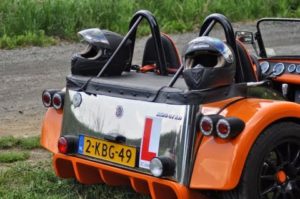 The next few hours were a blur of adrenaline and petrol fuelled excitement. The track is awesome in the “Shock & Awe” sense of the word. If you don’t know the circuit (17km and 43 corners) you approach almost every bend not knowing which way it will take you and normally with a third dimension involved: either banking, negative camber or a blind crest. Add to that some rain, high kerbs and no run-offs and you have one of the most difficult and dangerous tracks in the world. Jackie Steward christened it “Green Hell”.
The next few hours were a blur of adrenaline and petrol fuelled excitement. The track is awesome in the “Shock & Awe” sense of the word. If you don’t know the circuit (17km and 43 corners) you approach almost every bend not knowing which way it will take you and normally with a third dimension involved: either banking, negative camber or a blind crest. Add to that some rain, high kerbs and no run-offs and you have one of the most difficult and dangerous tracks in the world. Jackie Steward christened it “Green Hell”.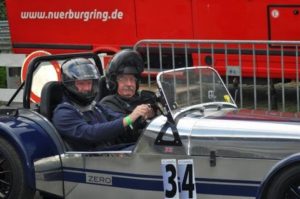 But what a sensation. My wife and I in my little garage built GBS, head to head (albeit briefly) with a 1.5m Euro Koenigsegg on a world class race circuit. That’s another one ticked off my Bucket List.
But what a sensation. My wife and I in my little garage built GBS, head to head (albeit briefly) with a 1.5m Euro Koenigsegg on a world class race circuit. That’s another one ticked off my Bucket List. Even though the majority of the drivers were veteran on this circuit the rain still took its toll. Racing was stopped three times whilst Porsches were prised from the scenery and the damage repaired. Whilst the day ended prematurely due to the bad weather, our spirits were high. What a day.
Even though the majority of the drivers were veteran on this circuit the rain still took its toll. Racing was stopped three times whilst Porsches were prised from the scenery and the damage repaired. Whilst the day ended prematurely due to the bad weather, our spirits were high. What a day.
My first attempt at a lap of the ring – the GoPro didn’t get past the scrutineers….
A slow wet lap with Graterham riding Shotgun
A semi wet lap
In spite of all that was going on around them, Bernd’s crew provided superb hospitality throughout the day: strong coffee and cake during the morning session and an excellent BBQ for lunch – thank you.
In the evening we went back to Centre Parcs and found one of the restaurants did an “all you can eat and drink” tariff – perfect!! We went to bed satiated and exhausted on so many levels.
Wednesday was another early start, but this time to trek home. We did the whole journey in one stretch this time – 12 hours driving in the pouring rain most of the way. When we got home my car was saturated inside and out. Motorway spray from the 550 miles had been pulled in through the open rear. But, nothing a good clean and some early summer sunshine couldn’t fix on Thursday. She put up a great performance and came through with flying colours.
Nurburgring Trip – 2nd June 2014
Nurburgring Nordschleife – 2nd June 2014
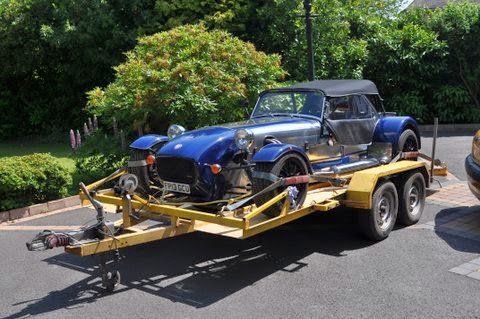 The day had finally come. After 6 months of thinking about it, it wss now time to put the thoughts into action. A good friend of mine kindly loaned me his car trailer (thank you once more Garry) and I loaded her aboard and strapped her down. With the doors and half-hood in place, the majority of the car is watertight (or so I thought, but I will come to that) with only the rear quarter lights each side open to the elements and a gap between the hood and the boot cover. The trailer plus the car equate to approximately 2/3rds the weight of my wife’s Rav4 that I was using to pull it. With a double axle trailer (with braking), this is well within legal limits but the Rav4 (2.0L petrol) was not really up to the job. The brakes and clutch took a pounding and I had to use all of the gears to get up some of the hills.
The day had finally come. After 6 months of thinking about it, it wss now time to put the thoughts into action. A good friend of mine kindly loaned me his car trailer (thank you once more Garry) and I loaded her aboard and strapped her down. With the doors and half-hood in place, the majority of the car is watertight (or so I thought, but I will come to that) with only the rear quarter lights each side open to the elements and a gap between the hood and the boot cover. The trailer plus the car equate to approximately 2/3rds the weight of my wife’s Rav4 that I was using to pull it. With a double axle trailer (with braking), this is well within legal limits but the Rav4 (2.0L petrol) was not really up to the job. The brakes and clutch took a pounding and I had to use all of the gears to get up some of the hills.  Stafford to Nurburgring is circa 550 miles and pulling a trailer that meant 12 hours of driving – a long way!! So we broke the journey on the outward leg with a stay at a hotel in Maidstone on Sunday night and an early crossing (8am) on Le Shuttle. We arrived at the Ring at 3:30pm to some sunshine and a warm welcome from our German host Bernd Backes. We then set up a “GBS area” across the road from the “Devil’s Diner” and the entrance to the Nordschliefe.
Stafford to Nurburgring is circa 550 miles and pulling a trailer that meant 12 hours of driving – a long way!! So we broke the journey on the outward leg with a stay at a hotel in Maidstone on Sunday night and an early crossing (8am) on Le Shuttle. We arrived at the Ring at 3:30pm to some sunshine and a warm welcome from our German host Bernd Backes. We then set up a “GBS area” across the road from the “Devil’s Diner” and the entrance to the Nordschliefe. 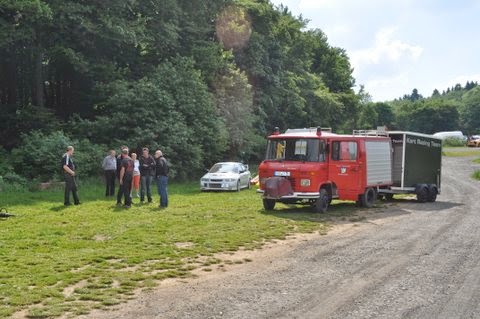 Bernd has an old Fire-Truck that he uses to transport the catering equipment, supplies and an essential mobile workshop for the cars.
Bernd has an old Fire-Truck that he uses to transport the catering equipment, supplies and an essential mobile workshop for the cars. 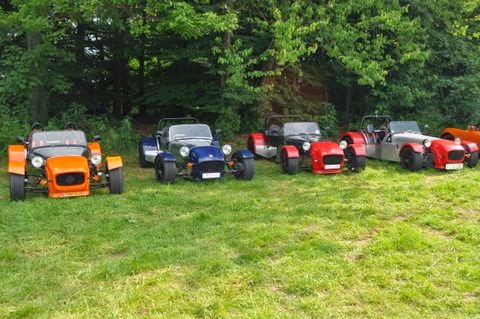 Once we picked a suitable place, we offloaded the cars and supplies. Don’t they look good!!
Once we picked a suitable place, we offloaded the cars and supplies. Don’t they look good!!
With the essentials in place it was time to recce the track. There was a “tourist” session going on which means that the Nordschliefe is treated as a German toll road. Anyone with a licence and a road legal car can pay the toll (27 Euros) and do a circuit. It was mayhem. There was everything from top end Mercs and BMWs to old battered Golf GTIs and everything in between, plus hundreds of bikers. It wasn’t long before the red flags appeared and the track closed whilst they cleared up the remains of another smash. I thought to myself – what have I let myself in for?
With that thought left in my mind and after a long day of pulling the trailer across England, France, Belgium, Holland and Germany, we headed to our hotel. Bernd had kindly provided a web site for local accommodation. On it, was Centre Parcs Eifel just 7 miles down the road – ideal.
Having used Centre Parcs in the UK many times when the children were smaller, we knew roughly what to expect. The “comfort” accommodation can be booked by the night and is clean but basic i.e. room with TV and bed, and bathroom with shower. Although we didn’t realise that bed linen WASN’T included – the German website didn’t seem to mention it. Not to worry, Reception were glad to supply some for an additional fee.
The catering was similar to the accommodation – simple yet satisfying: steak, chips and ice cold German lager – what more do you need??
Rattling Exhaust
My exhaust has never been the quietest, but recently it has developed a very loud rasping rattle at revs above 3000. Rather than the sound of a purring engine as you pull away, you have the sound of a rattling tin can – not good.
I went up to GBS last weekend and saw Richard@GBS. He said that occasionay the inner sleive within these new single can exhausts, can move backward and rattle against the rear of the outer casing. He gave me a few stainless rivets and told me to place a rivet about 2cm from the seam and somewhere that can’t be seen. This should stop the inner sleeve moving.
Well as you can see above (photo taken from below), I have done this and the awful noise is still there.
Pre-Nurburgring Training
 Although I have attended a couple of GBS Track Days recently I have never actually taken the car on the track. But this is going to change on 3rd June 2014 when I have registered for a track day at the Nurburgring with GBS and their German distributor.
Although I have attended a couple of GBS Track Days recently I have never actually taken the car on the track. But this is going to change on 3rd June 2014 when I have registered for a track day at the Nurburgring with GBS and their German distributor.
The day is a closed session (no public admittance) arranged by the German Pistenclub (pistenclub.de), so I have 8am until 16:30pm to do as many laps as I like along with 100 other cars.
As this is the first drive on a track for many years, I decided to get some professional help to brush up my technique and help me get a feel for my car at track speeds. If you were at Stoneleigh the other day you may have noticed a company called GEM Driver Training ( gemdrivertraining ). I noticed them in the magazine literature because they use an airfield close to me in Stafford.
Last Sunday I did their Track and Performance Driving Course. I can recommend it for anyone in my position. I wanted to understand some of the theory behind how a car handles on a track, and also brush up my track driving skills. Ewan Morris does an excellent job talking though car dynamics with the aid of some powerpoint.  He really understands what he is talking about as he has many driving teaching qualifications and many years of race experience. The session was not just theory either. We started in his Rover with some basic assessment and track orientation, but then I arranged for 1:1 tuition in my Zero for 45 minutes. Time to put the theory into practise. It was just what I needed. I now feel safer and more capable of enjoying a full day around the “Ring”. Thank you Ewan!!
He really understands what he is talking about as he has many driving teaching qualifications and many years of race experience. The session was not just theory either. We started in his Rover with some basic assessment and track orientation, but then I arranged for 1:1 tuition in my Zero for 45 minutes. Time to put the theory into practise. It was just what I needed. I now feel safer and more capable of enjoying a full day around the “Ring”. Thank you Ewan!!
Here’s his Facebook link GEM-Driver-Training
IACV Removal
As I have mentioned in several previous blogs, I have never been happy with the operation of the IACV. I believe the car only starts and idles because of two opposing problems: the first is that the IACV was wired back to front so even though it is turned off in the ECU it still remains circa 70% open when the ignition is on; the second is the diameter of the pipes leading into and out of it physically constrain the air flow. Together, these issues allow just sufficient air to the plenum to allow the car to start and idle (albeit very fast 1250 RPM warm idle). If I am right, then there is a third unseen problem. The airflow via the IACV is constant and un-metered, which means that the engine will be running lean. The proper answer is to install the IACV correctly along with a Lamda sensor and run closed loop, but I haven’t the time or inclination to do that at the moment since I have registered for the GBS Track Day at the Nurburgring in 2 weeks time. My priority is the get the car operating in the most reliable and predictable fashion ready for the trip to Germany. So I have decided to remove the IACV and revert the idle control to a simple throttle stop on the butterfly.
The proper answer is to install the IACV correctly along with a Lamda sensor and run closed loop, but I haven’t the time or inclination to do that at the moment since I have registered for the GBS Track Day at the Nurburgring in 2 weeks time. My priority is the get the car operating in the most reliable and predictable fashion ready for the trip to Germany. So I have decided to remove the IACV and revert the idle control to a simple throttle stop on the butterfly.
As you can see from the photo, it is quite a straight forward process to remove the threaded lug and replace with a standard bolt and a couple of nuts to lock it into position. The throttle can then be re-installed on the end of the plenum.
The real work in this job isn’t mechanical but it is in the trimming of the idle set-up in the ECU for warm idle and cold start. I found some instructions on the Emerald web site for trimming the warm idle:
If you disable the idle stabilisation function (as found in the “Idle control” page) and the overrun fuel cut off function (as found in the “Events” page) it will prevent these functions from hindering rather than helping while you initially get the engine fired up, throttles balanced and the idle set.
Assuming that the ECU is locking onto the crank sensor signal ok, then the main task is to get the engine fired up and up to temperature. This may (will probably) involve holding the throttle open slightly while you adjust the idle screw to hold the engine at a sensible rpm.
The next bit is a bit of a juggling act – you want to make sure that the fuelling is somewhere right, so just use the fuel trim keys (2 & 3) in the “Live adjustments” screen to add or take away fuel so the engine runs as smoothly as possible.
Once you’re happy that the engine is running smoothly, the engine rpm is ok for a hot idle speed and the throttles are fairly well balanced, you can shut the engine off and re-align the throttle position sensor via the PC software. Switch the ignition off/on (if you haven’t already) just to ensure that everything (e.g. fuel trims) are cleared, and re-start.
If you make changes to the MSPB number, keep the changes fairly small each time, (say steps of 4 or less) and remember to program the map to the ECU for the MSPB value change to take effect – you can do this with the engine running. The base map should get you most of the way there but the idle fuelling and very light throttle settings are most sensitive to injector/fuel pressure/engine differences so often require a little more attention and fine tuning.
Here is the link to the technical article on Cold Start Calibration.
Emerald_Cold_start_crib_sheet.pdf
Even though I am not an automotive engineer, following the process resulted in an engine that idles smoothly and starts without a problem from cold – albeit cold equating to 10 degrees at the moment. This may need some more work in the Winter.
Accelerator Pedal Stops
 Another small job I have been meaning to do. The pedal position for the accelerator has never been where I expect it to be. Normally it should sit just below the height of the brake pedal so that your foot can move horizontally from brake to accelerator swiftly without having to lift your foot. It should then travel to 100% throttle open and have a physical stop to avoid stretching the accelerator cable. Having taken your foot off the pedal it should return to where it was just below the height of the brake.
Another small job I have been meaning to do. The pedal position for the accelerator has never been where I expect it to be. Normally it should sit just below the height of the brake pedal so that your foot can move horizontally from brake to accelerator swiftly without having to lift your foot. It should then travel to 100% throttle open and have a physical stop to avoid stretching the accelerator cable. Having taken your foot off the pedal it should return to where it was just below the height of the brake.
As you can see on the left I have used a small spring to aid the throttle butterfly spring in returning the pedal back up. Then an M4 bolt covered in nylon fuel pipe to act as a pedal stop. The right hand photo shows the pedal box to which the pedal stop in anchored. I used the bulkhead as the final stop for 100% open. Much better.
Unsightly Rust
Doors
My Zero has been driving well since my last blog. Now well over 2000 miles on the clock, mainly from short blats around the local Staffordshire countryside. I’ve found a great route over Blithfield reservoir and up to Uttoxeter but that’s for another blog.
I was disappointed not to be able to join the RhoCar crew on their trip around Scotland last week ( ). I was actually in Scotland on holiday with the family, so took advantage of the great weather over the Bank Holiday, but the photos and videos from the RhoCar guys looked superb. Maybe next time.
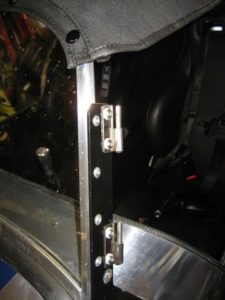 But back to the main subject of this blog: a new set of doors. The doors have been on order for well over 12 months now, but GBS’ supplier seemed to be playing games. Promising new stock each week that never arrived. But they are here now. I had imagined simply taking them out of the packaging and dropping them straight onto the hinges – but were would be the fun in that? They come flat packed and without the hinges attached. The challenge is to bend them to the right shape to fit around the car whilst also positioning the hinges correctly so the doors open around the mirrors and the half-hood, as well as looking aesthetically reasonable at the same time.
But back to the main subject of this blog: a new set of doors. The doors have been on order for well over 12 months now, but GBS’ supplier seemed to be playing games. Promising new stock each week that never arrived. But they are here now. I had imagined simply taking them out of the packaging and dropping them straight onto the hinges – but were would be the fun in that? They come flat packed and without the hinges attached. The challenge is to bend them to the right shape to fit around the car whilst also positioning the hinges correctly so the doors open around the mirrors and the half-hood, as well as looking aesthetically reasonable at the same time.
Firstly I mounted the lower hinges on the Y-frame on both sides and installed the half-hood. Then I bend the doors into roughly the right shape. There was a helpful post from Simon@GBS recently on the GBS forum, where he explains how to do this (http://www.gbsownersclub.co.uk/forum/technical-talk/doors). I didn’t follow it exactly, but it is useful to read though to acclimatise yourself with the complexity of the job. I have reproduced the text below as I am not sure if old posts will be archived on the forum.
“This could become complicated to explain, although relatively easy to do.

 And here is the finished result, although the anchoring straps to keep the doors closed couldn’t be fixed because there were no poppers in the door pack. I will call GBS tomorrow. I am sure Will@GBS will drop some in the post for me.
And here is the finished result, although the anchoring straps to keep the doors closed couldn’t be fixed because there were no poppers in the door pack. I will call GBS tomorrow. I am sure Will@GBS will drop some in the post for me.
A quick blat down the road and all is well – any excuse!!
IACV revisited
As I have mentioned in previous posts, my IACV has never really worked properly. It buzzes away to itself and allows the car to start and idle but I think this is a combination of a number of wrongs making a right: for a start it is wired incorrectly – to gnd rather than +12v and to the wrong pins.
Some investigations today…..
Rewired right back to the ECU and double checked the wiring – all OK. Walked back through the set-up advice from Emerald: Wire one pin on the valve to an ignition fed +12v supply. The other side goes to pin 3 (IACV Valve channel 1) on the Emerald ECU. In the PC software go to ECU Configuration and “Idle Air Control Valve motor options” and select 300Hz as the PWM value. If the configuration has to be changed then click the OK button and reset the ECU by switching the ignition on and off. Read up the map from the ECU and go to the “Idle Control” tab – press F5. Select “motor control mode” in the top right hand corner of this screen. Set the mode to “Fixed position manual control.” Re-program the map to the ECU.
- With my finger partially over the inlet pipe it showed that air was passing through the value – I could hear it and feel it and the engine revs dropped accordingly.
- With my finger completely over the inlet pipe and the engine cut out, so no air leaks into the manifold.
Spanner Check
Suddenly my car has done almost 1500 miles. One moment I am awaiting registration papers and the next it’s done 1500 glorious, grin producing miles – where did the autumn go? So it’s time to take a detailed look around and make sure everything is still as tight and true as it should be. With the car back up on stands, I took all the wheels off and painstakingly visited each bolt. In the main nothing had moved, but a couple needed a quarter turn now that everything had settled.
So it’s time to take a detailed look around and make sure everything is still as tight and true as it should be. With the car back up on stands, I took all the wheels off and painstakingly visited each bolt. In the main nothing had moved, but a couple needed a quarter turn now that everything had settled.
I also took the opportunity to look for anything amiss. Diff and drive shafts looked like new, as did the gearbox and clutch. The engine bay (looking from above) also looked (almost) pristine apart from some dust and general detritus from dirty roads. Water level and brake fluid level haven’t changed, but the oil level had dropped a little. Checking under the engine bay I can see a small oil leak at the back of the Raceline sump where it meets the gearbox. Well, I can’t see the leak, but I can see traces of oil. I am certainly not tempted to remove the engine to get a better look, so I guess I will simply have to live with it and keep an eye on the oil level. The oil pressure is fine.
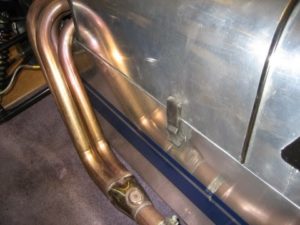 Took the opportunity to do another couple of jobs I have been meaning to do. Firstly installing some bonnet pins to stop the bonnet flaring out especially around the exhaust manifold. Looks much better.
Took the opportunity to do another couple of jobs I have been meaning to do. Firstly installing some bonnet pins to stop the bonnet flaring out especially around the exhaust manifold. Looks much better.
Secondly, adding a small cargo net for sunglasses and mobile phones.
Half Hood
Managed another quick blat around Blithfield Reservoir yesterday before the rain closed in. Second gear provided more lateral movement that forward movement, but that just widened my grin. Its great to ge the blood coursing through your veins again on a cool fresh morning.
With the onset of more poor weather I decided to install the half hood that has been sitting patiently in its box since the summer. I bought it from SoftBits4Sevens along with a shower cap. The logic behind this was: half hood for driving and shower cap for stationary/overnight. Together they were less that half the price of full weather gear from GBS.
Fitting turned out to be quite straight forward. At the rear the half hood fixes to the base of the rollbar supports where they meet the rear valance. No new holes necessary, just add the nylon loops to the existing anchor points. The windscreen mounting was not so simple as it involved drilling into the u-channel windscreen surround whilst the windscreen was in place. The edge of the glass was encountered on a couple of the holes, but the screen remained in one piece even with the rivets in place. Finally the side anchor points. I chose to overlap the boot cover slightly as the forward corners of the boot cover had a habit of turning out whilst driving. Overlapping them allowed me to add another popper and keep them tidy.
I think the hood look good, even though it is a cold day so the creases haven’t pulled out. It is also not as difficult as I thought to get in with the hood up as I had feared.
